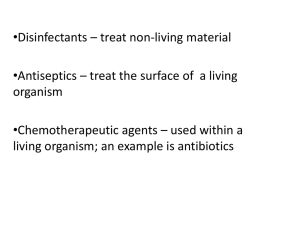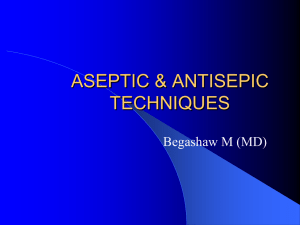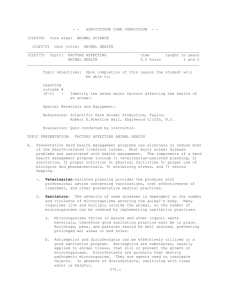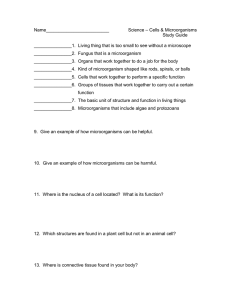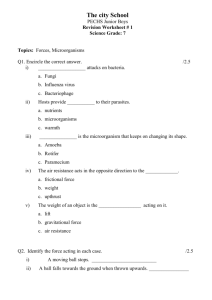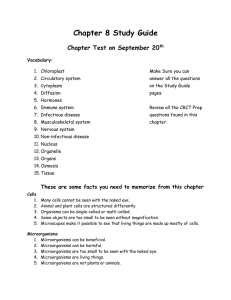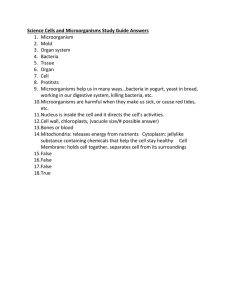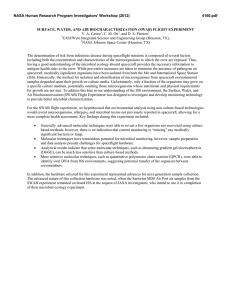USING DISINFECTANTS, ANTISEPTICS, AND SANITIZERS TO CONTROL MICROORGANISMS
advertisement
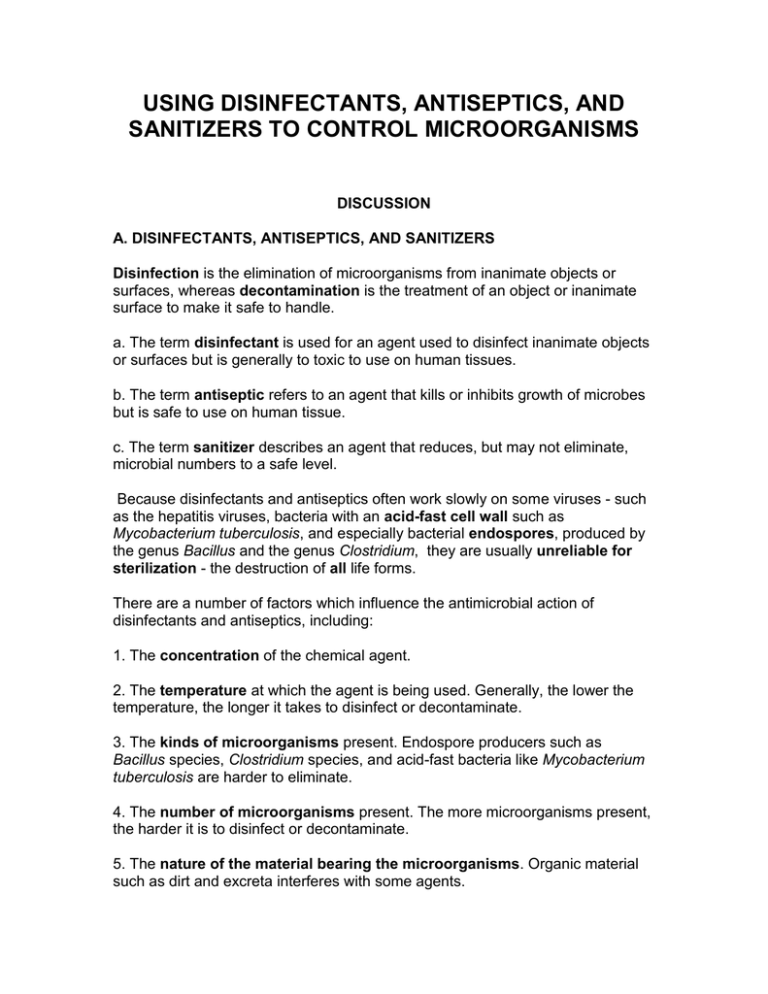
USING DISINFECTANTS, ANTISEPTICS, AND SANITIZERS TO CONTROL MICROORGANISMS DISCUSSION A. DISINFECTANTS, ANTISEPTICS, AND SANITIZERS Disinfection is the elimination of microorganisms from inanimate objects or surfaces, whereas decontamination is the treatment of an object or inanimate surface to make it safe to handle. a. The term disinfectant is used for an agent used to disinfect inanimate objects or surfaces but is generally to toxic to use on human tissues. b. The term antiseptic refers to an agent that kills or inhibits growth of microbes but is safe to use on human tissue. c. The term sanitizer describes an agent that reduces, but may not eliminate, microbial numbers to a safe level. Because disinfectants and antiseptics often work slowly on some viruses - such as the hepatitis viruses, bacteria with an acid-fast cell wall such as Mycobacterium tuberculosis, and especially bacterial endospores, produced by the genus Bacillus and the genus Clostridium, they are usually unreliable for sterilization - the destruction of all life forms. There are a number of factors which influence the antimicrobial action of disinfectants and antiseptics, including: 1. The concentration of the chemical agent. 2. The temperature at which the agent is being used. Generally, the lower the temperature, the longer it takes to disinfect or decontaminate. 3. The kinds of microorganisms present. Endospore producers such as Bacillus species, Clostridium species, and acid-fast bacteria like Mycobacterium tuberculosis are harder to eliminate. 4. The number of microorganisms present. The more microorganisms present, the harder it is to disinfect or decontaminate. 5. The nature of the material bearing the microorganisms. Organic material such as dirt and excreta interferes with some agents. The best results are generally obtained when the initial microbial numbers are low and when the surface to be disinfected is clean and free of possible interfering substances. There are 2 common antimicrobial modes of action for disinfectants, antiseptics, and sanitizers: 1. They may damage the lipids and/or proteins of the semipermeable cytoplasmic membrane of microorganisms resulting in leakage of cellular materials needed to sustain life. 2. They may denature microbial enzymes and other proteins, usually by disrupting the hydrogen and disulfide bonds that give the protein its threedimensional functional shape. This blocks metabolism. A large number of such chemical agents are in common use. Some of the more common groups are listed below: 1. Phenol and phenol derivatives Phenol (5-10%) was the first disinfectant commonly used. However, because of its toxicity and odor, phenol derivatives are now generally used. These include orthophenylphenol, hexachlorophene, triclosan, hexylresorcinol, and chlorhexidine. Orthophenylphenol is the agent in Lysol®, O-syl®, Staphene®, and Amphyl®. Hexachlorophene in a 3% solution is combined with detergent and is found in PhisoHex®. Triclosan is a chlorine-containing phenolic antiseptic very common in antimicrobial soaps and other products. Hexylresorcinol is in throat lozenges and ST-37. A 4% solution of chlorhexidine in isopropyl alcohol and combined with detergent (Hibiclens® and Hibitane®) is a common handwashing agent and surgical handscrub. These agents kill most bacteria, most fungi, and some viruses, but are usually ineffective against endospores. They alter membrane permeability and denature proteins. 2. Soaps and detergents Soaps are only mildly microbicidal. Their use aids in the mechanical removal of microorganisms by breaking up the oily film on the skin (emulsification) and reducing the surface tension of water so it spreads and penetrates more readily. Some cosmetic soaps contain added antiseptics to increase antimicrobial activity. Detergents may be anionic or cationic. Anionic (negatively charged) detergents, such as laundry powders, mechanically remove microorganisms and other materials but are not very microbicidal. Cationic (positively charged) detergents alter membrane permeability and denature proteins. They are effective against many vegetative bacteria, some fungi, and some viruses. However, bacterial endospores and certain bacteria such as Mycobacterium tuberculosis and Pseudomonas species are usually resistant. They are also inactivated by soaps and organic materials like excreta. Cationic detergents include the quaternary ammonium compounds such as benzalkonium chloride, zephiran, diaprene, roccal, ceepryn, and phemerol. 3. Alcohols 70% solutions of ethyl or isopropyl alcohol are effective in killing vegetative bacteria, enveloped viruses, and fungi. However, they are usually ineffective against endospores and non-enveloped viruses. Once they evaporate, their cidal activity will cease. Alcohols denature membranes and are often combined with other disinfectants, such as iodine, mercurials, and cationic detergents for increased effectiveness. 4. Acids and alkalies Acids and alkalies alter membrane permeability and denature proteins and other molecules. Salts of organic acids, such as calcium propionate, potassium sorbate, and methylparaben, are commonly used as food preservatives. Undecylenic acid (Desenex®) is used for dermatophyte infections of the skin. An example of an alkali is lye (sodium hydroxide). 5. Heavy metals Heavy metals, such as mercury, silver, and copper, denature proteins. Mercury compounds (mercurochrome, metaphen, merthiolate) are only bacteriostatic and are not effective against endospores. Silver nitrate (1%) is sometimes put in the eyes of newborns to prevent gonococcal ophthalmia. Copper sulfate is used to combat fungal diseases of plants and is also a common algicide. Selinium sulfide kills fungi and their spores. 6. Chlorine Chlorine gas reacts with water to form hypochlorite ions, which in turn denature microbial enzymes. Chlorine is used in the chlorination of drinking water, swimming pools, and sewage. Sodium hypochlorite is the active agent in household bleach. Calcium hypochlorite, sodium hypochlorite, and chloramines (chlorine plus ammonia) are used to sanitize glassware, eating utensils, dairy and food processing equipment, hemodialysis systems, and treating water supplies. 7. Iodine and iodophores Iodine also denatures microbial proteins. Iodine tincture contasns a 2% solution of iodine and sodium iodide in 70% alcohole. Aqueous iodine solutions containing 2% iodine and 2.4% sodium iodide are commonly used as a topical antiseptic. Iodophores are a combination of iodine and an inert polymers such as polyvinylpyrrolidone that reduces surface tension and slowly releases the iodine. Iodophores are less irritating than iodine and do not stain. They are generally effective against vegetative bacteria, Mycobacterium tuberculosis, fungi, some viruses, and some endospores. Examples include Wescodyne®, Ioprep®, Ioclide®, Betadine®, and Isodine®. 8. Aldehydes Aldehydes, such as formaldehyde and glutaraldehyde, denature microbial proteins. Formalin (37% aqueous solution of formaldehyde gas) is extremely active and kills most forms of microbial life. It is used in embalming, preserving biological specimens, and in preparing vaccines. Alkaline glutaraldehyde (Cidex®), acid glutaraldehyde (Sonacide®), and glutaraldehyde phenate solutions (Sporocidin®) kill vegetative bacteria in 10-30 minutes and endospores in about 4 hours. A 10 hour exposure to a 2% glutaraldehyde solution can be used for cold sterilization of materials. 9. Ethylene oxide gas Ethylene oxide is one of the very few chemicals that can be relied upon for sterilization (after 4-12 hours exposure). Since it is explosive, it is usually mixed with inert gases such as freon or carbon dioxide. Gaseous chemosterilizers, using ethylene oxide, are commonly used to sterilize heat-sensitive items such as plastic syringes, petri plates, textiles, sutures, artificial heart valves, heart-lung machines, and mattresses. Ethylene oxide has very high penetrating power and denatures microbial proteins. Vapors are toxic to the skin, eyes, and mucous membranes and are also carcinogenic. Another gas that is used as a sterilant is chlorine dioxide which denatures proteins in vegetative bacteria, bacterial endospores, viruses, and fungi. B. EVALUATION OF DISINFECTANTS, ANTISEPTICS, AND SANITIZERS It is possible to evaluate disinfectants, antiseptics, and sanitizers using either in vitro or in vivo tests. An in vitro test is one done under artificial, controlled laboratory conditions. An in vivo test is one done under the actual conditions of normal use. A common in vitro test is to compare the antimicrobial activity of the agent being tested with that of phenol. The resulting value is called a phenol coefficient and has some value in comparing the strength of disinfectants under standard conditions. Phenol coefficients may be misleading, however, because as mentioned earlier, the killing rate varies greatly with the conditions under which the chemical agents are used. The concentration of the agent, the temperature at which it is being used, the length of exposure to the agent, the number and kinds of microorganisms present, and the nature of the material bearing the microorganisms all influence the antimicrobial activity of a disinfectant. If a disinfectant is being evaluated for possible use in a given in vivo situation, it must be evaluated under the same conditions in which it will actually be used. Today we will do a test to see if different objects might carry microorganisms if not properly disinfected or decontaminated. C. EFFECTIVENESS OF HAND WASHING There are 2 categories of microorganisms, or flora, normally found on the hands. Resident flora are the normal flora of the skin. Transient flora are the microorganisms you pick up from what you have been handling. It is routine practice to wash the hands prior to and after examining a patient and to do a complete regimented surgical scrub prior to going into the operating room. This is done in order to remove the potentially harmful transient flora, reduce the number of resident flora, and disinfect the skin. Actual sterilization of the hands is not possible since microorganisms live not only on the surface of the skin but also in deeper skin layers, in ducts of sweat glands, and around hair follicles. These normal flora are mainly nonpathogenic staphylococci and diphtheroid bacilli. Today we will qualitatively evaluate the effectiveness of the length of washing time on the removal of microorganisms from the hands. PROCEDURES A. EVALUATIONS OF DISINFECTANTS, ANTISEPTICS, AND SANITIZERS MATERIALS sterile glass rods ("thermometers"), cotton swabs Trypticase Soy agar (TSA) plates; 4 tubes of sterile water each group 1 tube of a particular antiseptic mouthwash per group; 2 mouthwashes per table. 1 bottle of dishwashing detergent per class ORGANISMS Trypticase Soy broth culture a mixture of common opportunists (Escherichia coli, Pseudomonas aeruginosa). Trypticase Soy broth culture of Bacillus subtilis oral sample (your mouth) ANTISEPTICS tubes of one of the following antiseptics per group: Brand "X" mouthwash Brand "Y" mouthwash PROCEDURE FOR EVALUATION OF DISINFECTANTS, ANTISEPTICS, AND SANITIZERS Each group will test one particular antiseptic against each of the 3 organisms/ samples. Each pair of lab partners will test either the normal flora of his or her mouth, a mixture of common opportunists, or will test B. subtilis. 1. Take 2 plates of TSA and, using your wax marker, divide each plate in half. Label the 4 halves as follows: control, 5 seconds, 30 seconds, and 3 minutes. Also place the name of the antiseptic your group is testing, the name of the specimen being tested, and your group name or symbol on each plate. Take the third TSA plate and label it "soap and water." 2. Using a sterile swab for mouth samples, and flame-sterilized glass for other samples, place it in your mouth, in the mixture of common opportunists, or in the B. subtilis for 3 minutes. 3. After 3 minutes, place the swab/rod in your first tube of sterile water to rinse it briefly. 4. Remove the swab/rod from the water, let the excess water drip off, and streak the tip of the swab/rod on the control sector of the TSA plate. Be careful that the inoculum does not enter the other sector of the plate. 5. Place the swab/rod in the mouth (use a new sterile swab for the mouth), the mixture of common opportunists, or the B. subtilis a second time for 3 minutes. Then place it in your tube of antiseptic for 5 seconds. Remove the swab/rod from the antiseptic and rinse it briefly in your second tube of sterile water. Streak the tip of the swab/rod on the 5 second sector of the TSA plate. 6. Place the swab/rod in the specimen a third time (use a new sterile swab for the mouth) for 3 minutes. Then place it in your antiseptic tube for 30 seconds. Rinse it briefly in your third tube of sterile water, and streak the tip on the 30 second sector of the TSA plate. 7. Place the swab/rod a fourth time in the specimen (use a new sterile swab for the mouth) for 3 minutes. Then place it in your tube of antiseptic for 3 minutes. Rinse it briefly in your fourth tube of sterile water, and streak the tip on the 3 minute sector of the TSA plate. 8. Place the rod a final time in the specimen (use a new sterile swab for the mouth) for 3 minutes. Squeeze a small amount of dishwashing detergent on the rod and rinse swab/clean the rod using a wet paper towel. Rinse the rod under running water and streak the tip of the rod on the TSA plate labeled "soap and water." 9. Incubate the TSA plates upside down and stacked in the petri plate holder on the shelf of the 37°C incubator corresponding to your lab section until the next lab period. B. EFFECTIVENESS OF HAND WASHING MATERIALS 2 plates of Trypticase Soy agar (TSA) Sterile scrub brush Soap PROCEDURE FOR EFFECTIVENESS OF HAND WASHING (to be done by lab partners) 1. Using your wax marker, divide each TSA plate in half and label the halves 1 through 4. 2. Rub your fingers over sector 1 prior to washing your hands. 3. Using a scrub brush, soap, and water, scrub your hands for 2 minutes. Rub your damp fingers over sector 2. 4. Again scrub your hands with soap and water for 2 minutes and rub your fingers over sector 3. 5. Again scrub your hands with soap and water for 2 minutes and rub your fingers over sector 4. 6. Incubate the TSA plates upside down and stacked in the petri plate holder on the shelf of the 37°C incubator corresponding to your lab section until the next lab period.
